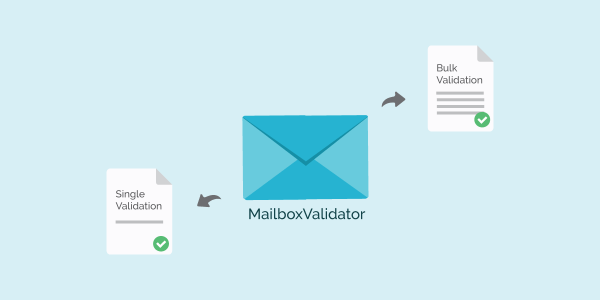MailboxValidator is an easy to use email address validation service. Users have an option to validate a single email address or do a bulk validation of a list of email addresses. Using an email address verifier service like MailboxValidator can help lower your email marketing campaign costs.
After you have performed email address verification, your email list will have less stale emails that will translate into fewer bounces.
Validating a single email address
The single email validation is pretty straightforward where the user signs in to our website and then selects Single Validation in the dashboard page. A text field will appear and all they have to do is key in the email address and press the Validate button. After a short while, the email validation results will be shown.
There is also an API if you want to integrate this form of validation into your programs. See our Single Validation API page for more info.
Validating a list of email addresses
In the same dashboard page, there is another option called Bulk Validation. With this one, the user just has to select a file of email addresses and press the Upload & Process button. Depending on the number of emails to be validated, the validations may take a while. On average, a list of 500,000 emails will take about a day to complete the validation.
The bulk validation can take a text file of email addresses with an email address per line as below:
sam@example.net
james@example.net
sandra@example.net
Alternatively, the user can also upload a CSV file with other data fields and our system will determine which field contains the email address as below:
“23234”,”James Warner”,”james@example.net”,”California”
“42133”,”Sandra Lim”,”sandra@example.net”,”New York”
“62134”,”Samuel Bishop”,”sam@example.net”,”Washington”
When the bulk validation process is completed, an email will be sent to the user and they can just sign in to our system and view the results or download the results in the form of a CSV file.
One thing to note for the bulk validation is that there is a queue for all uploaded files. If the uploaded file does not seem to have any progress, this could be due to the fact that it is in the queue. Rest assured that the file will be processed in due time.
What does the email validation result fields mean?
In the CSV result file, there are some fields with True or False values. Below are the meanings of those fields:
“domain” : This is the domain of the email address.
“is_free” : This indicates if the email address is from a free email provider like Gmail or Hotmail.
“is_syntax” : This indicates whether the email address is syntactically correct.
“is_domain” : This indicates whether the email address has a valid MX record in its DNS entries.
“is_smtp” : This indicates whether the mail servers specified in the MX records are responding to connections.
“is_verified” : This indicates whether the mail server confirms that the email address actually exists.
“is_server_down” : This indicates whether the mail server is currently down or unresponsive.
“is_greylisted” : This indicates whether the mail server employs greylisting where an email has to be sent a second time at a later time.
“is_disposable” : This indicates whether the email address is a temporary one from a disposable email provider.
“is_suppressed” : This indicates whether the email address is in our blacklist.
“is_role” : This indicates whether the email address is a role-based email address like admin@example.net, webmaster@example.net or support@example.net.
“is_high_risk” : This indicates whether the email address contains high risk keywords.
“is_catchall” : This indicates whether the email address is a catch-all address.
“mailboxvalidator_score” : Email address reputation score. Score > 0.70 means good; score > 0.40 means fair; score ≤ 0.40 means poor.
“time_taken” : The time taken to get the results in seconds.
“status” : This indicates whether our system thinks the email address is valid based on all the previous fields.

